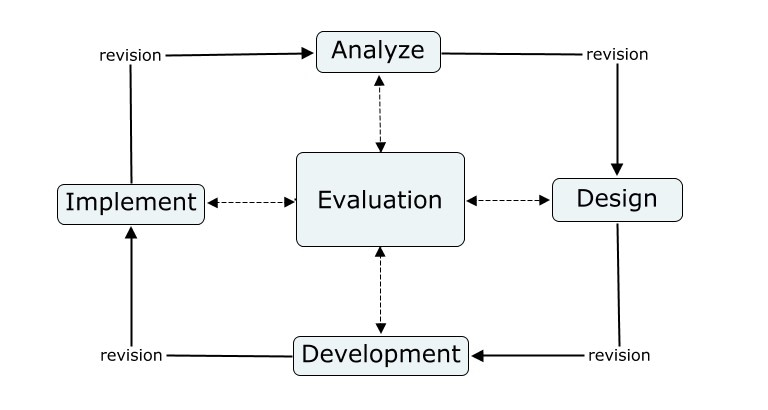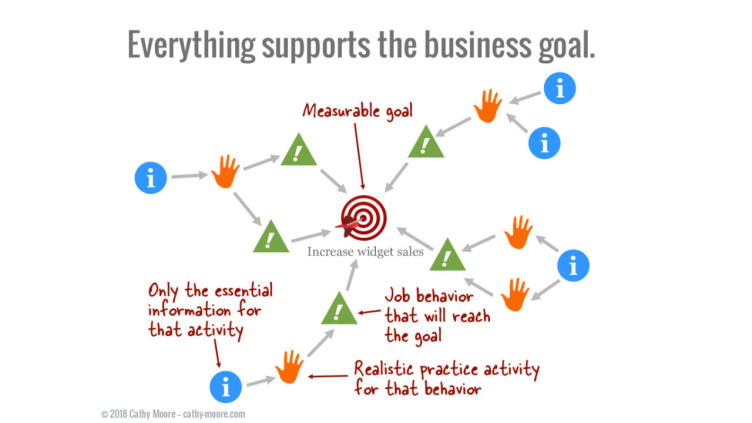According to research published by Chapman Alliance [1], it takes anywhere from 50 to over 700 hours to produce a single hour of elearning content. Needless to say, instructional designers are constantly looking for ways to streamline the process. That’s where instructional design models come in.
Designing, developing, and deploying elearning materials requires a structured approach. Using a tried-and-tested framework simplifies the creation process, allowing you to build more engaging, effective, and efficient training. But with so many choices, selecting the right instructional model for your needs can be challenging.
To help you, we’ve compiled six of the most popular instructional design models and listed a use case for each one.
What is an instructional design model?
An instructional design model is a systematic process used to create elearning content. It offers a set of guidelines to help instructional designers and trainers design, develop, deliver, and measure training initiatives.
This includes defining learning objectives, the target audience, training formats, and evaluation methods.
Why use instructional design models?
L&D teams are busier than ever as more businesses recognize the importance of continuous learning. As a result, industry professionals must quickly respond to growing training demands and roll out new elearning courses.
Instructional design models can help with this process in the following ways:
- A systematic instructional design approach ensures consistency across training content, making quality control easier.
- Following a blueprint for training content saves time and resources in the creation process.
- These models facilitate effective collaboration among instructional designers, subject matter experts (SMEs), and other stakeholders.
- Instructional frameworks enable you to better identify learners’ needs and preferences, so you can create learning experiences that align with them. It’s boosting engagement.
- Following a tried-and-tested model provides a clear process for evaluating the impact of training. This allows you to spot areas for improvement and optimize elearning content.
Most popular instructional design models in use
There’s a wide range of instructional design models to choose from, each with its own strengths and weaknesses. Therefore, it’s important to do your research and pick a model that best suits your training goals, audience, experience level, and available resources.
Here’s a breakdown of the six most popular instructional design models and a use case for each one.
- ADDIE model
- Action Mapping
- Bloom’s Taxonomy
- SAM Model
- Kirkpatrick Evaluation Model
- Merrill’s Principles of Instruction (MPI)
1. ADDIE model
The ADDIE model has been a popular instructional design framework since its inception in the seventies. It’s a five-step process that facilitates plenty of room for feedback.

Source: Wikipedia
How does it work?
Here are the five phases of ADDIE:
- Analysis: Analyze all the factors, including the problem, target audience, training needs, learning goals, and other key information.
- Design: Use the information from phase one to outline how you will achieve the learning goals. Then design a structure for the content and instructional strategies you’ll use.
- Development: Create learning materials, including videos, graphics, audio, and assessments.
- Implementation: Deliver your training course to learners.
- Evaluation: Assess the effectiveness of the training by measuring whether it achieved the learning goals. Identify areas for improvement and iterate.
Use case
While it may be too inflexible for some elearning projects, the structured nature of the ADDIE model makes it ideal for corporate compliance training.
Compliance training requires a systematic instructional approach to ensure that it meets the necessary regulations. With ADDIE, the creation process is linear, which allows course designers to properly document each step.
It also emphasizes the evaluation process, ensuring that training meets compliance standards. And, of course, that all employees have assimilated the critical knowledge.
2. Action Mapping
Created by Cathy Moore in 2008, action mapping is a simple process for designing training in the business world. It aims to identify the best training solution for specific performance issues, using scenario-based learning to engage learners and solve real-world problems.

How does it work?
Action Mapping is a four-step process:
- Identify the business goal: Define a measurable business goal to ensure you design relevant training activities that solve real problems.
- Identify what people need to do: Outline all the actions employees must take to reach the specific business goal.
- Design practice activities: Create training tasks that directly improve employees’ real-world performance in the workplace.
- Identify what people need to know: Pinpoint only the essential information employees need to complete each practice activity.
Use case
Action Mapping is one of the best instructional design models for promoting behavioral changes. As a result, it’s ideal for in-company soft skills training.
It starts by identifying performance goals and then systematically maps out all the actions employees need to take to achieve them. This makes it perfect for targeted training focused on improving on-the-job performance.
Action Mapping is most effective when it focuses on what employees in specific roles need to do differently to improve their performance. Having too wide an audience will make it challenging to design relevant practice activities.
3. Bloom’s Taxonomy
Bloom’s Taxonomy was first developed in 1956 by Benjamin Bloom and has since been updated by other educators. It’s useful for designing learning objectives and assessments that focus on specific cognitive skills.
How does it work?
Here are the six phases of Bloom’s Taxonomy:
- Remember: At this phase, learners can recall prior knowledge from their long-term memory. This includes memorizing facts, defining terms, and identifying concepts.
- Understand: Learners can use strategies to interpret, summarize, explain, and make logical conclusions from information.
- Apply: By this stage, learners can use what they’ve learned to solve problems in practical situations.
- Analyze: Learners now have the skill to break down complex information and identify patterns and relationships.
- Evaluate: At this phase, learners can assess and critique information. They now have the tools to make choices based on the information and defend their decisions.
- Create: Learners now have the ability to create original ideas and solutions based on their prior knowledge.
Use case
Bloom’s Taxonomy offers a hierarchical structure for instructional design. This means creating training activities that move learners from basic knowledge acquisition to critical thinking skills.
As a result, it’s a particularly effective model for language learning. Learners begin by remembering basic vocabulary and gradually work their way up to creating new thoughts in a second language and holding conversations.
4. SAM Model
The SAM (Successive Approximation Model) approach focuses on efficiency, collaboration, and iteration. Originally developed by Dr. Michael Allen, it offers an agile alternative to linear instructional design paths.
How does it work?
SAM1, the original model, has three phases:
- Preparation: This phase is all about collecting information, setting expectations, and planning. It’s also the time to identify the audience, set training goals, and create a roadmap.
- Iterative Design: During the second phase, you draft content, gather feedback, and revise your work. You’ll start with a prototype and iterate until you have a refined version.
- Iterative Development: Finally, you’ll take your refined prototype and develop and test it until you have the final product. Then it’s time to launch it.
There is also a more comprehensive version, aptly named SAM2. This version has a few additional phases, including Evaluation and Design Review.
Use case
The SAM model is iterative, making it excellent for projects that require high levels of user feedback or frequent modifications. An example would be software training.
Software applications tend to undergo regular changes and updates, so an iterative approach like SAM fits best.
SAM allows instructional designers to constantly tweak the training to align with the latest product updates.
5. Kirkpatrick Evaluation Model
The Kirkpatrick Evaluation Model was first published in 1959 by Donald Kirkpatrick, a professor emeritus at the University of Wisconsin. It’s a valuable tool for evaluating and analyzing the effectiveness of training programs.
How does it work?
The Kirkpatrick Evaluation model has four levels:
- Reaction: The first level evaluates how learners reacted to the training.
- Learning: At this level, it assesses to what extent learners improved their knowledge as a result of the training.
- Behavior: The third level evaluates whether learners transferred this newfound knowledge to on-the-job behaviors.
- Results: At the final stage, it assesses how the training impacted organizational goals.
Use cases
Kirkpatrick’s Model evaluates the across-the-board impact of training initiatives. It goes from assessing learners’ reactions to the program all the way to evaluating how it affects the business. As a result, this model is well-suited to leadership development training.
Leadership training impacts the organization at all levels. That’s why it requires a practical and multifaceted approach to measure its success.
The Kirkpatrick model provides you with a well-rounded idea of the overall success of your leadership training initiatives.
6. Merrill’s Principles of Instruction (MPI)
Merrill’s Principles of Instruction (MPI) is a task-centered approach to training. It aims to facilitate learning by including real-life tasks, encouraging learners to apply existing knowledge, and creating opportunities to apply new skills.
How does it work?
There are five phases in Merrill’s Principles of Instruction (MPI):
- Problem-centered: Step one is to present learners with real-world problems that they will regularly experience in their daily lives.
- Activation: The next step is to activate learners’ prior knowledge and experience to create a foundation for new information.
- Demonstration: The third step is to provide examples and models to demonstrate the new knowledge you want them to acquire.
- Application: At this stage, you must give learners opportunities to apply their newly gained knowledge in realistic situations. They should receive feedback on their performance.
- Integration: The final step is to encourage learners to integrate their new knowledge into their daily workflows.
Use cases
Merrill’s Principles of Instruction (MPI) is a practical model with a focus on achieving learning outcomes.
It places emphasis on problem-solving, hands-on application, and real-world scenarios. As such, it’s an ideal model for technical skills training. For instance, in the IT, manufacturing, and engineering fields.
Technical skills training requires learners to follow specific procedures to solve real-world problems or perform a task. The MPI model lends itself very well to this, giving trainees opportunities to practice in an environment that mimics the real world. That way, they can apply their knowledge and integrate new skills in a “safe” setting.
Final thoughts
These six popular instructional design models provide a reliable framework to follow during the elearning creation process. This can lead to more efficient collaboration, faster rollout times, better training outcomes, and higher learner engagement.
With so much at stake, choosing the right approach for your business is essential. Following the guidelines in this article can help you make the best decision for your learners.
Want to boost employee performance through training? Grab Map It by Cathy Moore to discover how to design corporate training that garners tangible results.

By Nicola Wylie
Nicola Wylie is a learning industry expert who loves sharing in-depth insights into the latest trends, challenges, and technologies.
